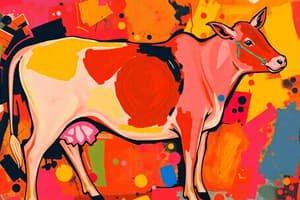Podcast
Questions and Answers
What is the purpose of reproduction in animals?
What is the purpose of reproduction in animals?
- To decrease population size
- To prevent genetic variation
- To ensure species survival (correct)
- To produce only male offspring
What is the process through which animals produce gametes?
What is the process through which animals produce gametes?
- Meiosis (correct)
- Fermentation
- Mitosis
- Photosynthesis
What is the result of the fusion of gametes during fertilization?
What is the result of the fusion of gametes during fertilization?
- Halving of chromosome number
- Zygote formation (correct)
- Production of gametes
- Formation of multiple blastocysts
What is the function of a blastocyst during embryonic development?
What is the function of a blastocyst during embryonic development?
Which process leads to the rapid growth and maturation of the fetus during prenatal development?
Which process leads to the rapid growth and maturation of the fetus during prenatal development?
What is the biological significance of genetic exchange during fertilization?
What is the biological significance of genetic exchange during fertilization?
Which process occurs in females to produce eggs?
Which process occurs in females to produce eggs?
What is the role of the nervous system during prenatal development?
What is the role of the nervous system during prenatal development?
What occurs after the zygote divides multiple times?
What occurs after the zygote divides multiple times?
What is the final stage in reproduction in animals as mentioned in the text?
What is the final stage in reproduction in animals as mentioned in the text?
Flashcards are hidden until you start studying
Study Notes
Reproduction in Animals: A Focus on Biological Processes
Reproduction in animals is a crucial aspect of life that ensures species survival. It involves several stages, ranging from gamete production and fertilization to embryonic and fetal development, culminating in birth. This process not only produces offspring capable of reproducing themselves but also enables genetic variation within a population—an essential feature for evolution and adaptation.
Gamete Production and Maturation
Animals produce specialized cells called gametes (eggs and sperm) through a process called meiosis. Meiosis halves the chromosomal complement, allowing for genetic exchange between individuals during fertilization. In males, spermatogenesis produces millions of sperm while oogenesis in females generates only a few eggs.
Fertilization and Embryonic Development
After maturation, gametes are released into the reproductive tract where they meet and fuse together, resulting in zygote formation. The zygote divides multiple times, forming a multicellular structure called a blastocyst. At this stage, early embryonic development begins, and the blastocyst implants itself onto the uterine wall to receive nutrients for further growth.
Prenatal Development and Birth
Throughout prenatal development, the embryo and later the fetus rapidly grow and mature. During gestation, organs develop, limbs form, and the nervous system becomes functional. Finally, birth occurs when the mother gives birth to her young either through live birth (as seen in placental mammals) or laying eggs (as observed in reptiles and birds).
In summary, reproduction in animals encompasses various biological processes that ensure the continuation of species. From gamete production and maturation to fertilization, prenatal development, and birth, each step plays a vital role in producing healthy offspring with unique genetic traits.
Studying That Suits You
Use AI to generate personalized quizzes and flashcards to suit your learning preferences.




